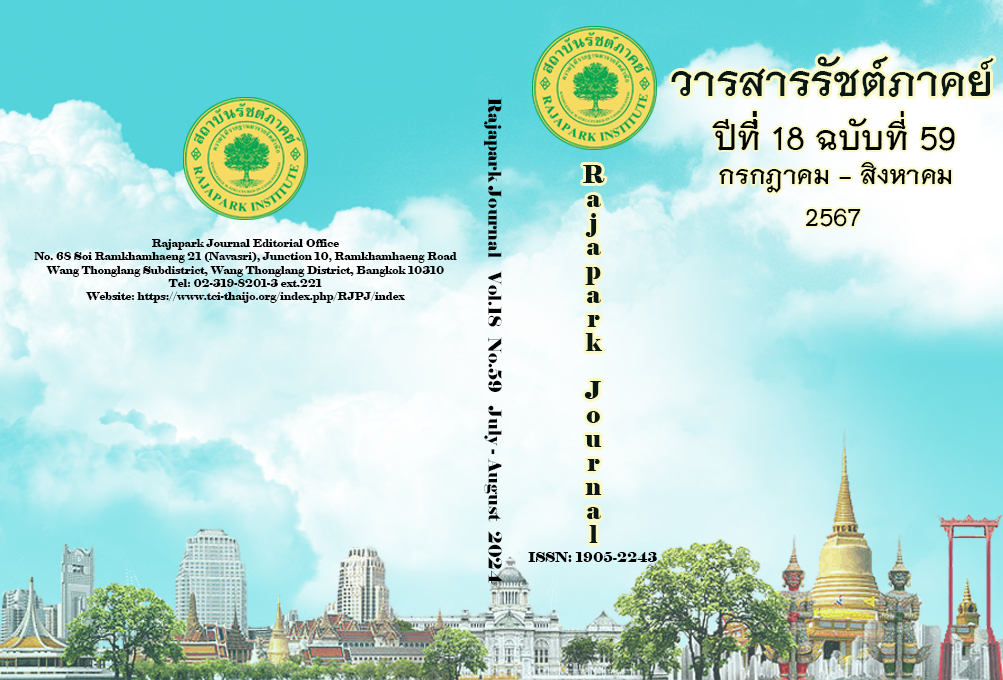Decoding Thai Digital Audiences: Social Media Usage and Engagement with Social Issues
Main Article Content
Abstract
This quantitative research aimed to investigate 1) social media usage patterns and 2) forms of interaction with social issues on social media among Thai digital audiences. Data were collected through an online survey using convenience sampling, with a sample size of 476 participants. Descriptive statistics were used for data analysis, including percentages, frequencies, means, and standard deviations. The results revealed that 1) the five most popular social media platforms among Thai digital audiences are Facebook, LINE, Instagram, YouTube, and TikTok. The top five social issues of interest to participants were livelihood and the economy, the Thai education system, politics, domestic violence, and employment, with varying levels of interest across age groups. Furthermore, 2) the majority of participants expressed a desire to engage with social issues through media, primarily motivated by the desire to collaborate with others, the belief that the issue is a problem that needs to be solved, and the feeling that the issue is personally relevant. However, some participants were hesitant or uninterested in taking part due to a lack of trust in the media, concerns about potential risks associated with participation, and insufficient information about the issues.
Article Details

This work is licensed under a Creative Commons Attribution-NonCommercial-NoDerivatives 4.0 International License.
Views and opinions appearing in the Journal it is the responsibility of the author of the article, and does not constitute the view and responsibility of the editorial team.
References
Broersma, M. (2019). Audience engagement. The International Encyclopedia of Journalism Studies, 1-6. DOI:10.1002/9781118841570.iejs0060
Choi, D. H. et al. (2018). Exploring risk perception and intention to engage in social and economic activities during the South Korean MERS outbreak. International Journal of Communication, 12, 21.
Cugelman, B. et al. (2011). Online interventions for social marketing health behavior change campaigns: A meta-analysis of psychological architectures and adherence factors. Journal of Medical Internet Research, 13(1), e1367.
Euajarusphan, A. (2018). Media usage behavior by Generation X And Generation Y. Journal of Social Communication Innovation, 6(1), 60-65. https://so06.tci-thaijo.org/index.php/jcosci/article/view/138056
Euajarusphan, A. (2021). Online social media usage behavior, attitude, satisfaction, and online social media literacy of Generation X, Generation Y, and Generation Z. Asian Interdisciplinary and Sustainability Review, 10(2), 44–58.
https://so05.tci-thaijo.org/index.php/PSAKUIJIR/article/view/255898
Ghersetti, M., & Westlund, O. (2018). Habits and generational media use. Journalism Studies, 19(7), 1039-1058. Https://doi.org/10.1080/1461670X.2016.1254061
Jin, L. et al. (2013). Understanding user behavior in online social Networks: A survey. IEEE Communications Magazine, 51(9), 144-150.
Jones, K., & Wadsworth, C. (2020). How COVID-19 has impacted media consumption, by Generation [Visualization]. Visual Capitalist. https://www.visualcapitalist.com/media-consumption-covid-19/
Kaewthep, K. (2000). Mass communication: Theories and research approaches. Chulalongkorn University Book Center.
Marciano, L. et al. (2022). Digital media use and adolescents' mental health during the COVID-19 pandemic: A systematic review and meta-analysis. Frontiers in Public Health, 9, 793868.
Mcquail, D. (1997). Audience analysis. SAGE Publications.
Meijer, I., & Groot Kormelink, T. (2018). Audiences for journalism. In International Encyclopedia of Journalism Studies (pp. 1-7). John Wiley & Sons.
Robinson, J. G. (2019). The audience in the mind's eye: How journalists imagine their readers. Columbia Journalism Review. Https://www.cjr.org/tow_center_reports/how-journalists-imagine-their-readers.php
Romer, D., & Jamieson, K. H. (2021). Patterns of media use, strength of belief in COVID-19 conspiracy theories, and the prevention of COVID-19 from March to July 2020 in the United States: Survey study. Journal of Medical Internet Research, 23(4), e25215.
Roonkaseam, N., & Srisarakam, S. (2023). Digital media use and social engagement among Thai audiences. Faculty of Communication Arts, Chulalongkorn University & Program Management Unit for Human Resources & Institutional Development, Research and Innovation (PMU-B).
Srisaracam, S. et al. (2024). Digital media and audience participation with social issues. Faculty of Communication Arts, Chulalongkorn University.
Tao, W., et al. (2024). The power of emotional appeal in motivating behaviors to mitigate climate change among Generation Z. Journal of Nonprofit & Public Sector Marketing, 36(1), 37-64.
Thansettakij. (2024, May 23). Situation of the use of information and communication technology in households. Https://www.thansettakij.com/technology/technology/589776
Wachinger, G. et al. (2013). The risk perception paradox—implications for Governance and communication of natural hazards. Risk Analysis, 33(6), 1049-1065.
Yuwakosol, S., & Chompookum, P. (2021). Opinion and media usage among generations in the digital age. Journal of Social Communication Innovation, 9(2), 10-25.
HD Online News, Economics Market Live Program. (2024, May 23). Summary of internet usage statistics among Thai people. Https://news.ch7.com/detail/705217


